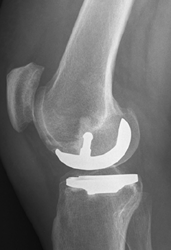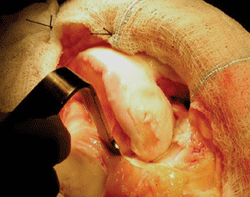Lateral unicompartmental replacement: A difficult but rewarding procedure
The rarity of the procedure adds to its difficulty, but one physician says the results can be worth it.
Click Here to Manage Email Alerts

Though it is a rare and difficult operation, the results from a properly performed lateral unicompartmental replacement can be more than satisfactory, according to a Boston orthopedist.
Performing the operation properly is a matter of selecting the right patients and following the techniques outlined by many others, Richard D. Scott, MD, said at the Current Concepts in Joint Replacement (CCJR) Winter 2009 meeting.
The rarity of the lateral unicompartmental replacement is one of its most distinguishing features, Scott said. This can contribute to the difficulty with performing one.
“The most important characteristic of the lateral unicompartmental replacement is that it is performed less frequently than the medial,” Scott said. “The medial/lateral ratio in most of our practices is about 10 to 1. Think about it — if you do 100 total knees a year, you are going to do maybe 10 unicompartmentals and maybe one lateral unicompartmental.”
A number of differences
Scott outlined that the patella is far more vulnerable to impingement on the leading edge of the femoral component and thus must be carefully recessed. Since the wear pattern in lateral disease is more posterior than in medial disease, there is often residual cartilage on the distal femoral condyle. To avoid this impingement, the residual cartilage should be removed from the distal condyle prior to resection and the femoral component should be under-sized anteriorly.
|
|
|
Images: Scott RD |
“You must balance this increased distal femoral resection with a minimal proximal tibial resection,” Scott added. “Otherwise, very thick tibial components will be necessary and may go beyond the maximum thickness available with the system that you are using.”
Shifting laterally
Further differences include erring toward shifting the femoral component laterally and the tibial component medially to maximize mediolateral congruency, avoiding excessive posterior tibial slope and considering a medial parapatellar approach — avoiding the anterior horn of the medial meniscus — to facilitate visibility and component alignment.
“Remember, since the wear pattern is posterior you want to discourage posterior tracking of the femur on the tibia,” Scott said. “Avoid excessive posterior tibial slope. I tend to put 0° to 3° of posterior slope in my lateral unicompartmentals.”
|
|
Cementing
Scott recommended cementing the tibia first, which is similar to what would probably be done in a medial unicompartmental, but he had other recommendations for the rest of the procedure.
“Pack cement into the slot or lug holes depending on the system you are using, but just smear a thin film on the plateau,” he said. “The remainder of the cement goes on the back of the tibial component to prevent posterior extrusion. As you insert the component, place it posteriorly first, and as it comes down the cement will come forward where you have access to it.”
Technique sensitive results
Jess H. Lonner, MD, another member of the CCJR faculty, agreed that unicompartmental arthroplasty could be effective but stressed that there are aspects to keep in mind.
“It is important to recognize that many of the patients who receive unicompartmental arthroplasty are young and active,” he said. “They want to recover quickly. These patients do not want to be out of work for a long period of time, and with unicompartmental arthroplasty we can get them back in action more quickly and very predictably – especially with the newer technologies available.”
“I agree that the results are technique-sensitive, and one of the important elements that contributes to durability is surgical precision. The surgeon should learn to do them well or refer the patient to someone who does,” he added.
For more information:
- Jess H. Lonner, MD, is Director of Knee Replacement Surgery at Pennsylvania Hospital, 800 Spruce St., Philadelphia, PA 19107-6130; 215-829-2461; e-mail: lonnerj@pahosp.com. He is a consultant and member of the speakers bureau for Zimmer, Inc., and MAKO Surgical Corp. He receives royalties from Zimmer and is a shareholder with MAKO.
- Richard D. Scott, MD, is a professor of orthopedic surgery at Harvard Medical School. He can be reached at 125 Parker Hill Ave., Boston, MA 02121. 617-738-9151; e-mail: rscott@partners.org. He is a consultant for and receives royalties from DePuy and is a member of the scientific advisory board for ConforMIS, Inc.
References:
- Sah AP, Scott RD. Lateral unicompartmental knee arthroplasty through a medial approach. Study with a five-year follow-up. J Bone Joint Surg (Am). 2007;89(9):1948-1954.
- Sah AP, Scott RD. Lateral unicompartmental knee arthroplasty through a medial approach. Surgical technique. J Bone Joint Surg (Am). 2008;90(suppl. 2 pt 2):195-205.
- Scott RD. The lateral uni: A road less traveled. Paper #72. Presented at the Current Concepts in Joint Replacement Winter 2009 meeting. Orlando, FL. Dec. 9-12, 2009.




